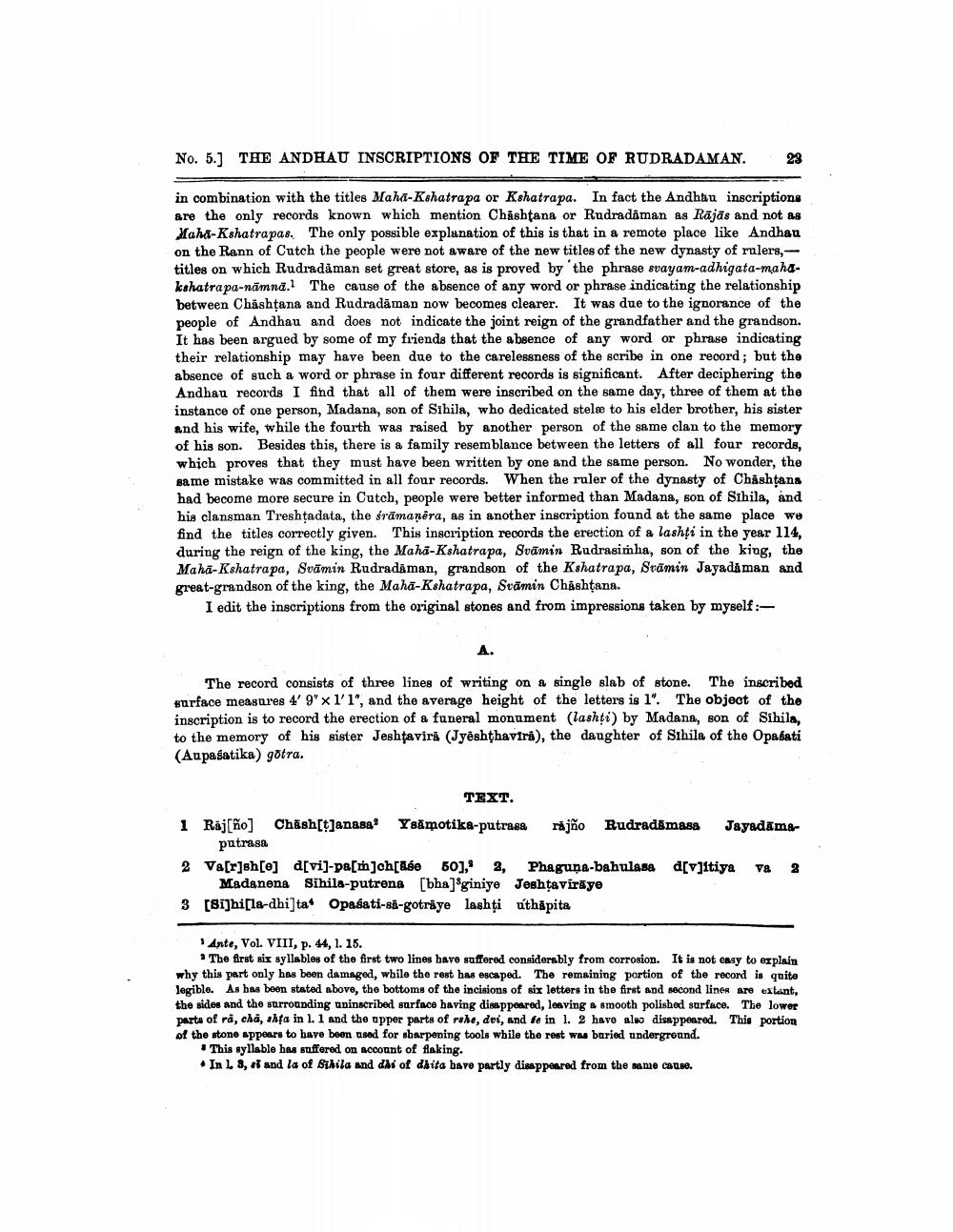________________
No. 5.] THE ANDHAU INSCRIPTIONS OF THE TIME OF RUDRADAMAN.
23
in combination with the titles Maha-Kshatrapa or Kshatrapa. In fact the Andhan inscriptions are the only records known which mention Chashtana or Rudradāman as Rājās and not as Xaha-Kshatrapas. The only possible explanation of this is that in a remote place like Andhau on the Rann of Cutch the people were not aware of the new titles of the new dynasty of rulers,titles on which Rudradåman set great store, as is proved by the phrase svayam-adhigata-mahakshatrapa-nämna. The cause of the absence of any word or phrase indicating the relationship between Chashtana and Rudradāman now becomes clearer. It was due to the ignorance of the people of Andhau and does not indicate the joint reign of the grandfather and the grandson. It has been argued by some of my friends that the absence of any word or phrase indicating their relationship may have been due to the carelessness of the scribe in one record; but the absence of such a word or phrase in four different records is significant. After deciphering the Andhau records I find that all of them were inscribed on the same day, three of them at the instance of one person, Madana, son of Sibila, who dedicated stelæ to his elder brother, his sister and his wife, while the fourth was raised by another person of the same clan to the memory of his son. Besides this, there is a family resemblance between the letters of all four records, which proves that they must have been written by one and the same person. No wonder, the same mistake was committed in all four records. When the ruler of the dynasty of Chishtans had become more secure in Cutch, people were better informed than Madana, son of Sihila, and his clansman Treshtadata, the frāmaņēra, as in another inscription found at the same place we find the titles correctly given. This inscription records the erection of a lashti in the year 114, during the reign of the king, the Maha-Kshatrapa, Svāmin Rudrasimha, son of the king, the Maha-Kshatrapa, Svämin Rudradaman, grandson of the Kshatrapa, Stamin Jayadå man and great-grandson of the king, the Maha-Kshatrapa, Svamin Chåshtana.
I edit the inscriptions from the original stones and from impressions taken by myself:
The record consists of three lines of writing on a single slab of stone. The inscribed surface measures 4' 9" x 1'1", and the average height of the letters is 1". The object of the inscription is to record the erection of a funeral monument (lashti) by Madana, son of Sibila, to the memory of his sister Jeshtavir. (Jyėshthavira), the daughter of Sıhila of the Opasati (Aupaśatika) gotra.
TEXT. 1 Raj[ho] Chash[t]anasa Ysmotika-putrasa räjño Rudrad mass Jayadāms
putrasa 2 Va[r]sh[e] d[vi]-pa[m]ch[Ase 50], 2, Phaguna-bahulasa d[v]itiya va 2
Madanena Sihila-putrens [bha]*giniye Joshtaviraye 3 [Si]hi[la-dhi]ta. Opasati-sa-gotraye lashti uthäpita
Ante, Vol. VIII, p. 44, 1. 15.
* The first six syllables of the first two lines have suffered considerably from corrosion. It is not easy to explain why this part only has been damaged, while the rest has escaped. The remaining portion of the record is quite legible. As has been stated above, the bottoms of the incisions of six letters in the first and second lines are extant, the sides and the surrounding uninscribed surface having disappeared, leaving a smooth polished surface. The lower parts of ra, cha, shfa in l. 1 and the upper parts of rshe, doi, and fe in l. 2 have also disappeared. This portion of the stone appears to have been used for sharpening tools while the rest was buried underground.
This syllable has suffered on account of flaking. • In L 8, and la of Bikila and dki of dhita bave partly diappeared from the same cause.




